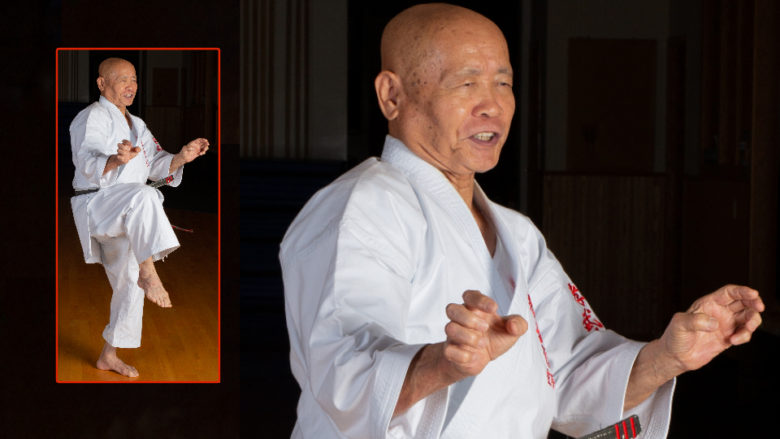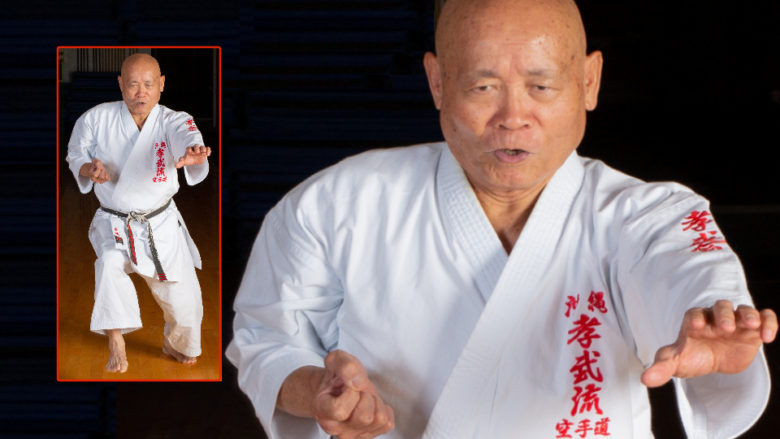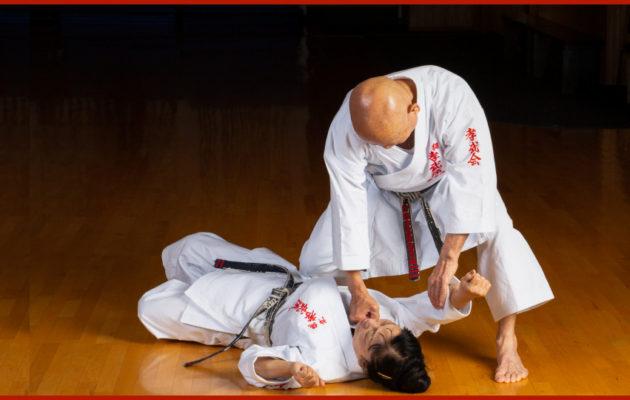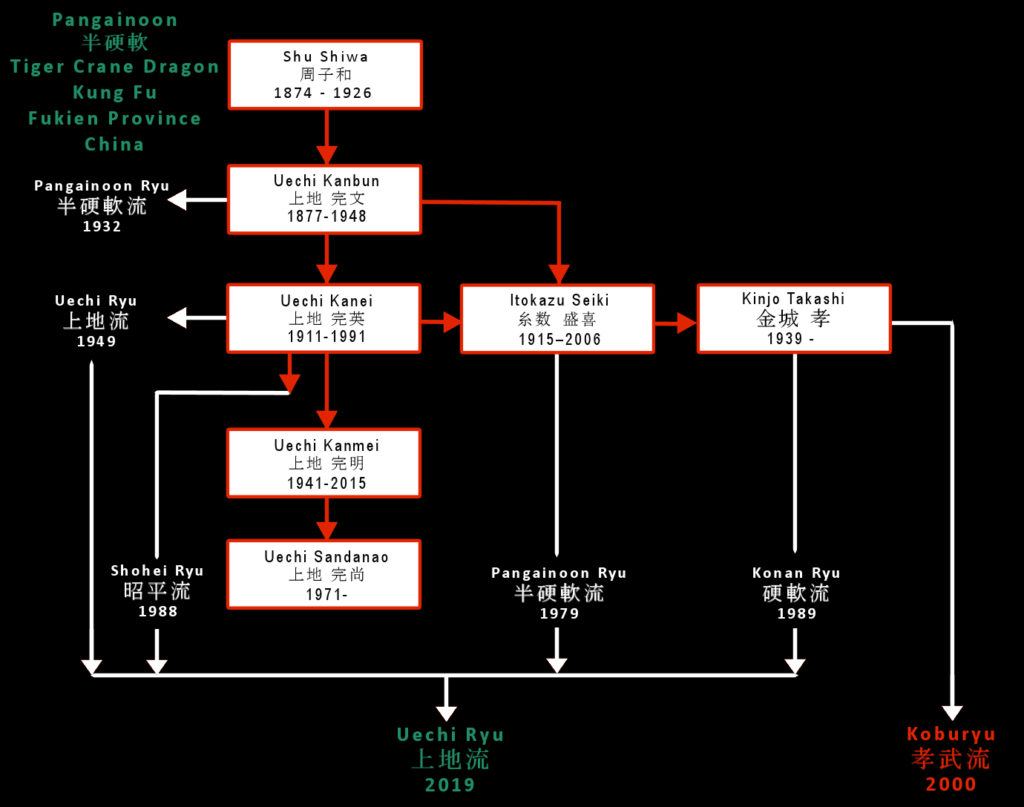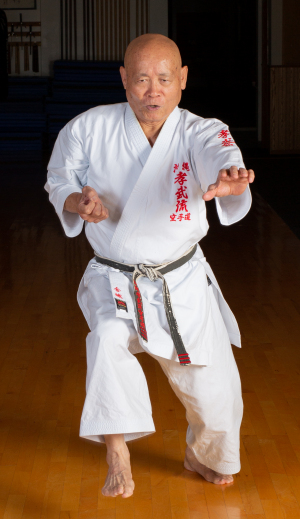The foremost element of every karate style is the kata. A kata is an imaginary battle. By simulating an actual fighting situation, the practitioner can begin to experience the movements of the kata at full speed and full power without having to be concerned about injuring a training partner.
Kata
There are nine karate kata of Kōburyū. All but one of the Kōburyū kata originated in Uechi Ryū.
Three kata were brought from China by Uechi Kanbun: sanchin, seisan and sanseiryu. Under Uechi Kanei, Uechi Kanbun’s son, several more kata were created to round out the style: kanshiwa, dainiseisan, seichin, seiryu and kanchin. The ninth kata, kobuken, was created by Sōke Kaichō Kinjō in the 1970’s. It serves as an introduction to the Kōburyū style of movement.
The kata of Kōburyū listed in the order that the student learns them.
- Sanchin
- Kanshiwa
- Dainiseisan
- Kobuken
- Seichin
- Seisan
- Seiryu
- Kanchin
- Kobu No Sanseiryu
1. Demonstrate accuracy, power, control,
dynamic movement and efficient combinations of moves
That is quite a list of requirements. Fortunately, Sōke Kaichō Kinjō has beginning, intermediate and advanced versions of every kata. Together these provide a well-defined path from performance of a technically accurate kata to a powerful and dynamic kata to a kata of true battle intent.
Shokyu
The purpose of the beginner level of kata is to develop accuracy of movement. That is why Sōke Kaichō Kinjō believes that a student should spend 80% of his training time on the basic level of kata.
Chukyu
The purpose of the intermediate level is to bring power to the kata from the legs and and control through grabbing.
Jokyu
The jōkyū version of the kata differs the most from its Uechi Ryū roots. The purpose of the advanced level is speed originating from simultaneous block and attack.
2. Develop both sides of the body
It is important to develop both sides of the body for a balanced development of the muscles of the body. It is also important for versatility in a real battle. The three key training elements of Kōburyū, kata, taisabaki waza and even bunkai, are practiced using both the right and left versions.
3. Every movement has a practical application
Sōke Kaichō Kinjō has revised the kata so that every movement has a practical application. Nothing exists in the kata just for show. Just as there are beginning, intermediate and advanced levels of the kata, there are also beginning, intermediate and advanced applications for the moves of the kata.
4. Finish the opponent in such a way that he cannot continue to fight
Sōke Kaichō Kinjō believes that one should perform a kata with the feeling that ones life depends on it. Have an image in your mind of the attack and how you can defend against it.
Hojoundō
Hojoundō (補助 運動) means “supporting exercises.” Hojoundō can be:
- A set of warm-up exercises
- An aid to learning a new technique
- A method to drill the right and left sides of the body
- A great way to build muscle memory for a more complicated combination of moves.
- The hojoundō need not be limited to the exercises defined by your instructor. You can create your own to suit your current training needs.
Taisabaki Waza
Taisabaki waza (体捌き 技) means “body movement techniques.” These exercises are specifically designed to teach the movement style of Kōburyū. In order to develop the skills using both sides of the body, the taisabaki waza are drilled alternating left and right sides.
There are more than thirty different taisabaki waza which are practiced first for correct movement and later with a partner to explore the possible applications of the technique.
At first taisabaki waza may seem like a thing apart from the kata. Only later does one realize that, while practicing taisabaki waza, one has been learning timing and distance, grabbing for control, simultaneous block and attack and other lessons necessary to move from beginner performance of a kata to true understanding of the mock battle.
Bunkai
The word bunkai (分解) means “analysis.” While beginning students are offered basic explanations of the movements of the kata, advanced students have the freedom to explore the secrets of the kata and create their own bunkai for the kata.
Bunkai is performed with a partner to learn timing and distance, grabbing for control, simultaneous block and attack – all the same lessons as taisabaki waza. Instead of focusing on just one small aspect of a kata at a time, bunkai puts it all together into a no-longer-imaginary mock battle. A bunkai performed by advanced partners will have true fighting spirit.
